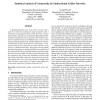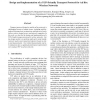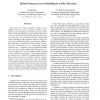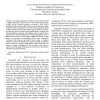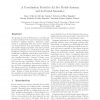ICPPW
2002
IEEE
14 years 4 months ago
2002
IEEE
A unidirectional link exists in an ad-hoc network when a node B is within the transmission range of another node A while node A cannot directly hear node B. However, a reverse rou...
ICPPW
2002
IEEE
14 years 4 months ago
2002
IEEE
In traditional ad hoc networks, all nodes are considered equal and take equal part in the routing and forwarding of packets. We believe that this may not always be desirable. Rath...
ICNP
2002
IEEE
14 years 4 months ago
2002
IEEE
Transport protocol design for mobile ad hoc networks is challenging because of unique issues, including mobilityinduced disconnection, reconnection, and high out-of-order delivery...
ICNP
2002
IEEE
14 years 4 months ago
2002
IEEE
We present the hybrid activation multiple access (HAMA) protocol for ad hoc networks. Unlike previous channel access scheduling protocols that activate either nodes or links only,...
AINA
2010
IEEE
14 years 4 months ago
2010
IEEE
— Growing popularity of wireless ad hoc networks leads to higher demands on performance of all TCP/IP stack layers. Usually ad hoc networks operate according to IEEE 802.11 stand...
IFIP
2003
Springer
14 years 4 months ago
2003
Springer
Many network level services such as routing, auto-addressing and, security have been proposed for ad hoc networks. Each has characteristics that may cause it to outperform similar ...
IFIP
2003
Springer
14 years 4 months ago
2003
Springer
The TCP protocol exhibits poor performance in multi-hop Mobile Ad Hoc Networks (MANETs). The ultimate reason for this is that MANETs behave in a significantly different way from ...
EUROPAR
2003
Springer
14 years 4 months ago
2003
Springer
The growing success of wireless ad hoc networks and portable hardware devices presents many interesting problems to software engineers. Particular, coordination is a challenging t...
ADHOCNOW
2003
Springer
14 years 4 months ago
2003
Springer
The growing popularity of ad hoc networks is making their limitations, such as bandwidth and power restrictions, more apparent. As a result, techniques that reduce power consumpti...
SPAA
2003
ACM
14 years 4 months ago
2003
ACM
An ad hoc network is a collection of wireless mobile hosts forming a temporary network without the aid of any fixed infrastructure. Indeed, an important task of an ad hoc network...
